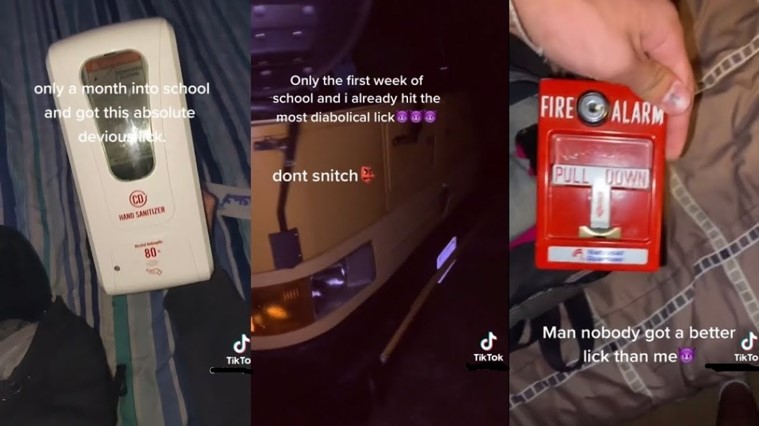Preventing Vandalism Trends Requires More Than Simply Disciplining Participants
December 14, 2021
Most of us who own a smartphone use social media: Instagram, Snapchat, TikTok, WhatsApp, you name it. It’s a platform to connect with people across the globe, post and share stories about what’s happening, or even make a change. Through social media, we can hop on the latest trends. But left untamed, social media becomes a hotspot for trending criminal activity.
An example of such a trend is the “devious licks” that have started on the video-sharing app TikTok. According to the Urban Dictionary, a lick is a “successful type of theft which results in an acceptable, impressive and rewarding payday for the protagonist.” Participants would share their latest thefts on Tiktok and boast about them, saying things like “Only a week into school and got this absolute devious lick.”
This trend began when a TikTok user @jugg4elias recorded himself with a box of masks on TikTok and gained over 239,000 views in a week. Soon afterwards, other TikTok users would join him, posting their own “devious licks” and racking up millions of views in diverse locations within a few days.
Participants in this trend stole various school supplies including microscopes and chairs, ripped soap dispensers off the walls, broke mirrors, and even clogged toilets just to show off their latest lick. In one school, students damaged the restroom to the point that it had to close. In another, students stole fire alarms and classroom telephones. All these acts — for a fifteen-second video on TikTok.
Schools responded in various ways, ranging from issuing notices on their websites and closing the damaged restrooms to prevent vandalism to letting school resource officers arrest the students. Sunlake High School in Florida stated, “We love our Seahawks and we do not want to see any of them arrested so PLEASE talk to your kids. If they are participating in this activity you will be hearing from an administrator and our School Resource Officer. Let’s work together to put a stop to this now.” A Marion County school, also in Florida, noted that they arrested six participating students, charging them with property damage.
Radnor High School responded with a PA announcement and a Schoology update. “The administrative team wants to make it clear that any student caught vandalizing our property will be handled and provided disciplinary consequences including suspension from school,” Dr. MacNamara wrote on September 10.
TikTok eventually shut down this trend after witnessing the property damage, stating that they “are removing this content and redirecting hashtags and search results to [their] Community Guidelines to discourage such behavior.”
Unfortunately, merely taking trends down, making announcements about the illegality of vandalism, and disciplining students will not stop a Devious Lick 2.0 or some similar trend. These measures only address the symptom of the trends but not why students are doing this in the first place. Maybe vandalism incidents will stop at one school, but another school nearby may continue to suffer. After all, like all other issues, you can only thoroughly solve it by addressing the root causes.
Viewing the trend and the acts of vandalism through students’ lenses can help. It is tempting to dismiss participants as “stupid,” “insane,” or “delusional,” but please don’t.
Maybe students vandalize because they long for a “normal” school environment, thus committing these acts to “celebrate” the occasion. After all, schools shutting down completely because of the pandemic and transitioning to a hybrid or virtual schedule with limited extracurriculars seriously hurt students’ social lives, causing them to crave for in-person contact.
Maybe students vandalize because, in addition to longing for a normal school environment, they desire the most-craved things on social media: likes, views, comments, and shares. After all, suddenly cutting in-person activities meant that millions of people, especially teenagers, turned to social media to continue staying in touch with friends and acquaintances. Combined with the mental health effects of COVID-19 and the measures taken to stop its spread, the mental health effects of social media, and the feeling that a sense of fame might alleviate the mental health concerns, the desire for clout on social media proliferates. The “devious licks” of TikTok are just one example.
Therefore, the solutions must tailor to students’ needs in regard to trends. Simply saying certain behaviors are not okay will not work. It gives the sense that students’ choices are being restricted.
Simply disciplining students for participating also won’t work. “We always make sure that any mistake/infraction made by a student is a learning experience. It is important that our students know that we all make mistakes, some larger than others,” Mrs. Kevgas remarked.
Providing a counterexample for the “devious licks” might work. For example, there is another TikTok trend called “angelic yields” that does the opposite of the devious licks. Originating from the TikTok user @j.uher7 with a video captioned “No more devious licks around here,” this trend has featured students placing soap dispensers, toilet paper, and even small sums of cash.
Through this TikTok fad, trend culture has shown both its dark side and its light side. To move the internet in a more positive direction, one that doesn’t condone vandalism, we must look at the full picture: where misunderstanding students and their methods of “fun” won’t make a difference in negative behavior, highlighting the positive aspect of trend culture will.







